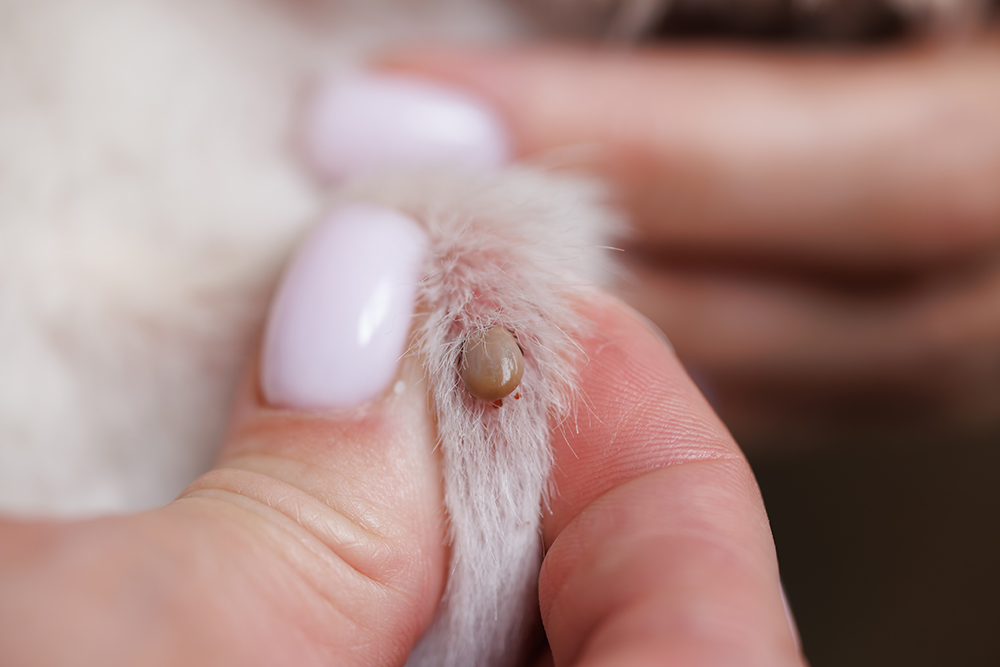Ticks are a common problem in Massachusetts, particularly in areas like Amesbury, Newburyport, Hamilton, Wenham, and the surrounding towns. If you’ve found a tick on your dog, it’s crucial to remove it promptly to avoid the spread of diseases like Lyme disease. Here’s how you can safely and effectively remove a tick from your dog and protect their health.
Why Tick Removal is Important
Ticks are small parasites that attach themselves to your dog’s skin to feed on their blood. These pests are known to transmit serious diseases such as Lyme disease, babesiosis, and anaplasmosis, which can cause severe health issues for your pet. In Massachusetts, tick populations are high, especially in wooded areas and tall grass, which means your dog could easily pick up a tick during walks or outdoor playtime. Proper and timely tick removal is essential to preventing the transmission of these diseases.
How to Safely Remove a Tick from Your Dog
1. Gather the Necessary Tools
You’ll need a pair of fine-tipped tweezers or a tick removal tool, gloves, and rubbing alcohol to safely remove the tick. Keep a clean container or bag on hand to place the tick in after removal for disposal or identification.
2. Calm Your Dog
Before starting the removal process, make sure your dog is calm and relaxed. You might want to have someone hold your dog steady or distract them with treats while you work.
3. Remove the Tick Carefully
Using fine-tipped tweezers or a specialized tick removal tool, grasp the tick as close to your dog’s skin as possible. Avoid squeezing the body of the tick, as this could cause it to release harmful bacteria into your dog’s bloodstream. Pull the tick out slowly and steadily, without twisting, to ensure that the entire tick is removed.
4. Clean the Area
After you’ve removed the tick, clean the bite area thoroughly with rubbing alcohol or antiseptic to reduce the risk of infection.
5. Dispose of the Tick Properly
Place the tick in a container with rubbing alcohol to kill it. Avoid crushing the tick with your fingers, as this could expose you to harmful bacteria. You can also save the tick in case you need to identify it or if you suspect your dog has been exposed to a tick-borne disease.
6. Monitor Your Dog for Symptoms
Even after removing the tick, keep an eye on your dog for any signs of illness, such as fever, loss of appetite, or lethargy. If you notice any symptoms, contact your veterinarian for advice on next steps.

Preventing Tick Infestations
While tick removal is important, prevention is the key to protecting your dog from tick-borne diseases. Regular tick prevention methods include:
• Tick Repellents: Use tick repellents recommended by your vet.
• Frequent Inspections: Check your dog’s coat regularly for ticks, especially after outdoor activities.
• Maintain a Clean Yard: Keep your yard trimmed and free of tall grass and weeds, where ticks like to hide.
• Tick-Proof Your Dog’s Environment: Avoid walking your dog in heavily wooded areas or tall grasses, especially during peak tick season.
When to Seek Professional Help
If you’re unsure how to remove a tick safely or if your dog has an adverse reaction after tick removal, it’s important to seek professional help. Safer Nature Pest Control offers expert tick control services in Amesbury, Newburyport, Hamilton, Wenham, and other towns across Massachusetts. Our eco-friendly solutions help prevent tick infestations around your home, reducing the risk of tick-borne diseases for your dog and family. Contact us today for more information about our tick removal and prevention services.

